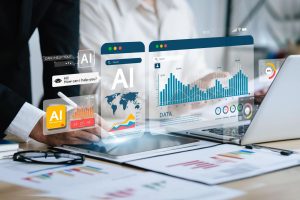Digital marketing has transformed dramatically in recent years. What once relied on manual processes and broad messaging now demands precision, speed, and data-driven decisions. As technology continues to evolve, businesses no longer guess what works; they track, analyze, and respond in real time.
Artificial intelligence drives this transformation. Marketers now use AI to uncover patterns, predict customer behavior, and deliver personalized content at scale. Instead of juggling repetitive tasks, teams use AI-powered tools to automate workflows, segment audiences, and optimize campaigns for better performance.
In this blog, you’ll discover how AI-powered marketing automation helps businesses work smarter. You’ll learn how it increases efficiency, sharpens personalization, and boosts overall campaign performance.
Whether you’re building your first automated funnel or leveling up an existing strategy, these insights will help you create more meaningful customer experiences while saving time and resources.
What is AI-powered marketing automation?
Marketing automation refers to using software to streamline, schedule, and manage repetitive marketing tasks. These include sending emails, posting on social media, segmenting audiences, and tracking customer behavior. Traditional automation follows a set of rules. It works well for basic workflows, but it lacks flexibility and doesn’t learn or adapt over time.
AI-powered marketing automation takes that foundation and adds intelligence. With artificial intelligence, marketing tools can go beyond simple instructions. They learn from user interactions, detect patterns, and make decisions in real time.
Instead of sending the same email to everyone, AI can analyze behavior and deliver content that matches each person’s interests, timing, and likelihood to convert.
This advanced functionality relies on several key technologies that work together to elevate traditional marketing automation into an intelligent, adaptive system:
Machine learning (ML)
Machine learning allows systems to analyze data and continuously improve outcomes based on patterns, trends, and feedback loops. In a marketing context, ML predicts what content resonates most with different audience segments. It analyzes user behavior to determine which subject lines attract more opens, which calls-to-action generate more clicks, and which creatives drive conversions.
Over time, the system fine-tunes these elements without manual intervention, helping marketers improve campaign performance with less guesswork and more data-driven decisions.
Natural language processing (NLP)
Natural language processing gives machines the ability to understand, interpret, and respond to human language. In marketing automation, NLP powers tools like AI chatbots that answer customer questions conversationally and intelligently.
It also drives content generation platforms that assist with writing emails, captions, or blog posts tailored to specific audiences. Sentiment analysis tools rely on NLP to evaluate how customers feel based on reviews, feedback, or social media comments, allowing businesses to adjust tone, timing, or messaging in real time.
Predictive analytics
Predictive analytics uses historical data, behavioral signals, and machine learning models to forecast future customer behavior. These insights allow marketers to anticipate when a customer might make another purchase, respond to a promotion, or disengage entirely.
With this information, brands can schedule outreach at the most impactful moment, customize offers based on likely interests, and prioritize leads with the highest conversion potential. Predictive models turn raw data into actionable strategies that move customers closer to the next step in their journey.
Together, these tools make digital marketing smarter. AI doesn’t replace strategy. It elevates it. When used effectively, AI-powered automation helps marketers reach the right audience with the right message at the right time, every time.

Key benefits of using AI in marketing automation
AI-powered marketing automation transforms how brands connect, engage, and grow. By blending data-driven insights with real-time adaptability, AI reshapes digital marketing strategies in powerful ways. Here’s how:
Smarter segmentation and targeting
AI processes massive amounts of customer data in seconds. Instead of relying on broad categories, AI identifies specific patterns in user behavior, browsing habits, purchase history, and engagement signals.
This precision allows marketers to create highly defined audience segments that reflect real intent, preferences, and needs. Micro-segmentation means every message feels tailored and timely, which increases engagement and conversion.
Personalized customer experiences at scale
Consumers expect brands to know them. AI delivers on that expectation by generating dynamic content, custom product recommendations, and personalized emails based on individual behavior.
AI also personalizes web experiences, adapting page layouts, offers, and messaging to match a visitor’s history and interests. This level of one-to-one marketing once required entire teams to manage. Now, AI makes it possible instantly and at scale.
Enhanced campaign performance and optimization
AI doesn’t wait for monthly reports to optimize campaigns. It monitors performance in real time, running A/B tests automatically and adjusting variables like subject lines, creative, or delivery times based on what performs best. This continuous learning cycle improves ROI and reduces wasted spend. Marketers get faster results and deeper insights with fewer manual adjustments.
Predictive analytics for better decision-making
With predictive analytics, AI anticipates what your customers will do next. It identifies users likely to churn, predicts the best time to send an offer, and suggests products before a customer starts browsing. These insights help brands make proactive decisions that improve lifetime value and reduce acquisition costs.
Increased efficiency and saved time
AI streamlines repetitive tasks such as scheduling emails, qualifying leads, and responding to common customer queries. By taking over routine functions, AI frees up your marketing team to focus on strategy, creativity, and high-impact projects. The result is a more agile team that produces stronger outcomes without burning out.
AI-powered marketing automation turns data into action. It helps brands stay agile, build lasting customer relationships, and maximize every digital marketing dollar with smarter, faster, and more effective strategies.
Use cases across the customer journey
AI-powered marketing automation strengthens every stage of the customer journey. From first impression to brand loyalty, AI helps marketers deliver the right message at the right time with precision and ease. Here’s how AI supports each step:
Awareness: Capture attention with curated content and targeted reach
At the top of the funnel, your goal is visibility. AI helps you reach the right audience with curated content based on trending topics, audience behavior, and platform performance. Machine learning tools identify which headlines, formats, and topics attract the most clicks.
AI also enhances paid media by refining audience targeting. Platforms like Google Ads and Meta use AI to predict which users are most likely to engage, helping you stretch your budget and increase brand exposure.
Consideration: Engage leads with personalization and automation
Once a user shows interest, AI deepens engagement. Intelligent chatbots provide instant answers, recommend helpful resources, and guide users through product options. Personalized nurture sequences driven by behavioral triggers deliver emails or content tailored to individual interests.
AI also makes retargeting more effective. It selects the most compelling message and timing for each user, ensuring your brand stays top of mind while building trust and credibility.
Purchase: Remove friction and drive conversions
AI simplifies and improves the buying experience. Smart checkout flows adjust based on device, behavior, or cart history. Personalized offers — such as abandoned cart discounts or add-on recommendations — encourage buyers to complete their purchase or increase order value.
Real-time optimization ensures that users see the most relevant content or offer, reducing bounce rates and boosting conversion.
Retention: Keep customers engaged and loyal
After the sale, AI keeps the conversation going. Automated re-engagement sequences revive inactive customers through timely reminders or tailored offers. AI also powers loyalty programs by tracking user activity and rewarding behavior that encourages return visits.
For example, a frequent shopper might receive a thank-you coupon or early access to a new product. These personalized touches build trust and long-term loyalty.
AI enhances every stage of the customer lifecycle. Whether you’re reaching a new audience, nurturing interest, or retaining loyal fans, automation helps you move faster, connect deeper, and convert smarter.
Challenges and considerations
While AI-powered marketing automation unlocks powerful benefits, successful implementation requires awareness of key challenges. These considerations help ensure your strategy remains effective, ethical, and aligned with your brand’s long-term goals.
Respect data privacy and build trust
AI systems depend on data. The more they learn from user behavior, preferences, and engagement patterns, the more accurate and helpful their responses become. However, collecting and using that data comes with responsibility.
Businesses must comply with regulations such as GDPR and CCPA, while also earning the trust of their audience. Be transparent about how you collect and use data. Offer clear opt-in choices, secure your systems, and prioritize consent.
Trust grows when users feel confident that their personal information remains safe and respected.
Select the right tools for your size and strategy
Not every AI platform fits every business. Large enterprises might need full-scale automation suites with built-in machine learning, while smaller companies benefit from more focused tools that streamline specific tasks like email sequences or lead scoring. Take time to assess your needs, team capacity, and growth plans.
Choose tools that match your goals and scale with you as your strategy evolves. Overinvesting in complex platforms may overwhelm your team, while underutilizing essential features limits your potential.
Combine automation with human oversight
AI makes marketing smarter, but it doesn’t replace human creativity, empathy, or judgment. Machines analyze data and optimize delivery, but people understand context, brand voice, and emotional nuance.
Regularly review your automated campaigns. Make sure the content aligns with your brand and resonates with your audience. Use insights to improve performance, but always keep a human perspective at the heart of your message. Automation supports your efforts, but real connection comes from thoughtful strategy and authentic communication.
By addressing these challenges proactively, you ensure your AI-powered marketing stays responsible, strategic, and customer-focused. With the right foundation, AI becomes a trusted partner in your marketing success.
Getting started with AI-powered marketing automation
Launching your journey with AI-powered marketing automation starts with clarity and intention. To make the most of this advanced technology, begin by laying a solid foundation that supports your business goals and growth trajectory.
Evaluate your current marketing stack
Begin by auditing the platforms, tools, and systems that support your marketing efforts. Examine how your customer relationship management (CRM) software tracks leads, how your email platform manages segmentation and delivery, and how your analytics tools report on campaign performance.
Take note of inefficiencies, such as systems that do not communicate with each other or tools that require excessive manual input. Pay close attention to workflows that create bottlenecks or lack transparency. This evaluation helps you understand where your stack performs well and where AI-powered tools could streamline execution or enhance insight.
Pinpoint areas where automation delivers the most value
Once you understand your setup, identify recurring tasks that eat up valuable time without requiring much creativity or human touch. These typically include email follow-ups, ad bidding, content scheduling, and basic customer service inquiries.
Review user journeys to find where prospects drop off or where they disengage after purchasing. These moments offer opportunities to insert automated messages, dynamic content, or timely offers that keep your audience engaged.
Focus your efforts on these friction points where automation improves experience, speeds up decision-making, or drives revenue.
Begin with one or two powerful tools
Rather than overhauling your entire system, take a focused approach by selecting a small number of AI-powered tools with the potential to produce meaningful results quickly. Choose tools that align with a specific goal, such as increasing email engagement, improving lead scoring accuracy, or refining ad performance.
Make sure your new tools integrate smoothly with your current ecosystem to avoid technical debt or unnecessary complexity. Lean into platforms that offer reliable customer support, user education, and a strong community, especially during the onboarding and testing phase.
Define key performance indicators and monitor progress
Before implementing automation, clarify the outcomes you want to achieve. Choose KPIs that reflect real progress, such as conversion rate lift, reduction in customer churn, or increase in lifetime value.
Monitor these metrics through dedicated dashboards that provide up-to-date visibility across your marketing channels. Schedule regular reviews to evaluate performance, identify patterns, and uncover opportunities for refinement.
This disciplined approach ensures that your automation efforts stay aligned with business goals and evolve as you gather data and feedback.
Turn potential into performance with Revity
![]()
AI-powered marketing automation is not a trend; it is the future of growth-focused strategy. From personalized customer experiences to real-time optimization and predictive insights, AI helps brands build smarter campaigns and stronger relationships. But unlocking these benefits requires the right tools, clear goals, and a team that understands how to bring it all together.
Ready to streamline your marketing, increase conversions, and grow with confidence?
At Revity, we help you eliminate guesswork and manual bottlenecks with smart, scalable marketing automation.
Our team of digital strategists and creative experts collaborates with you to design data-driven campaigns that attract attention and guide your audience through every step of the customer journey.
Whether you’re looking to personalize email flows, optimize paid ads in real time, or create seamless multichannel experiences, we build systems that do the heavy lifting so you can focus on big-picture growth. From CRM integration to performance tracking and everything in between, we combine cutting-edge tools with proven strategy to accelerate your success.
Turn your next campaign into a high-performing, automated engine that nurtures leads, converts more buyers, and keeps customers coming back. Contact Revity today and discover what’s possible when strategy meets innovation and execution never falls short. Let’s build your future, one automated success at a time.







